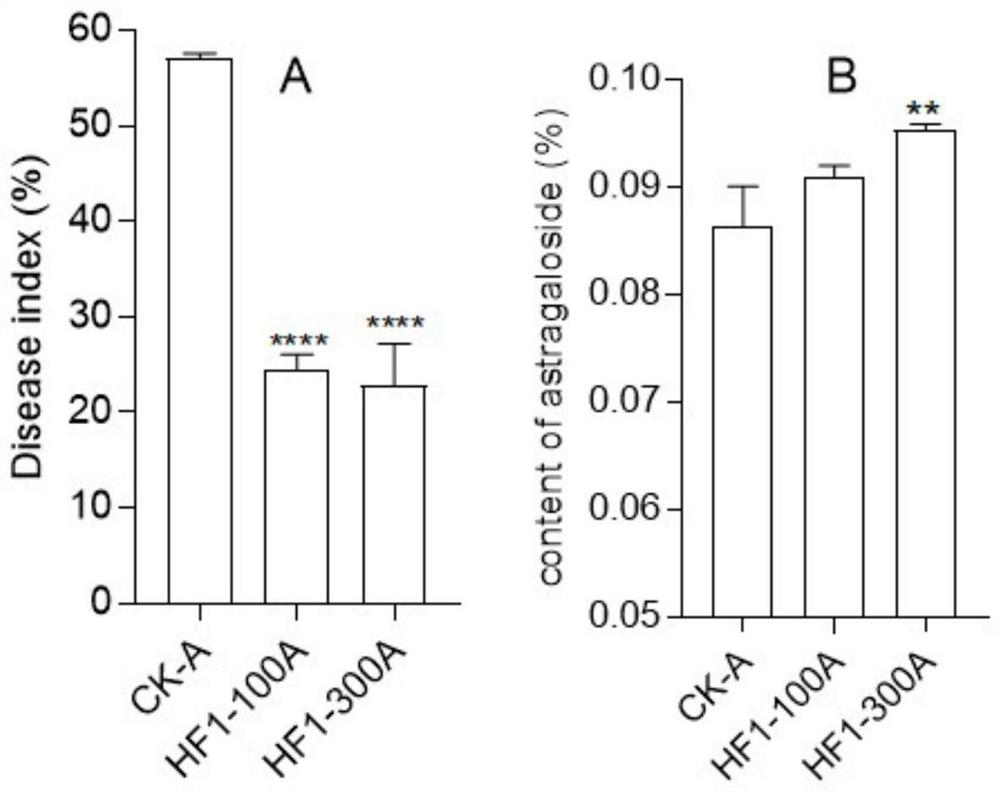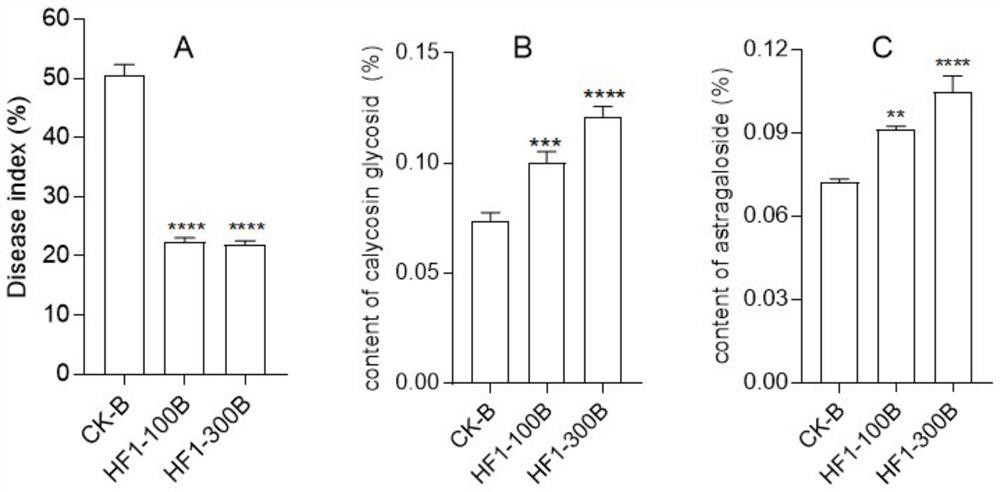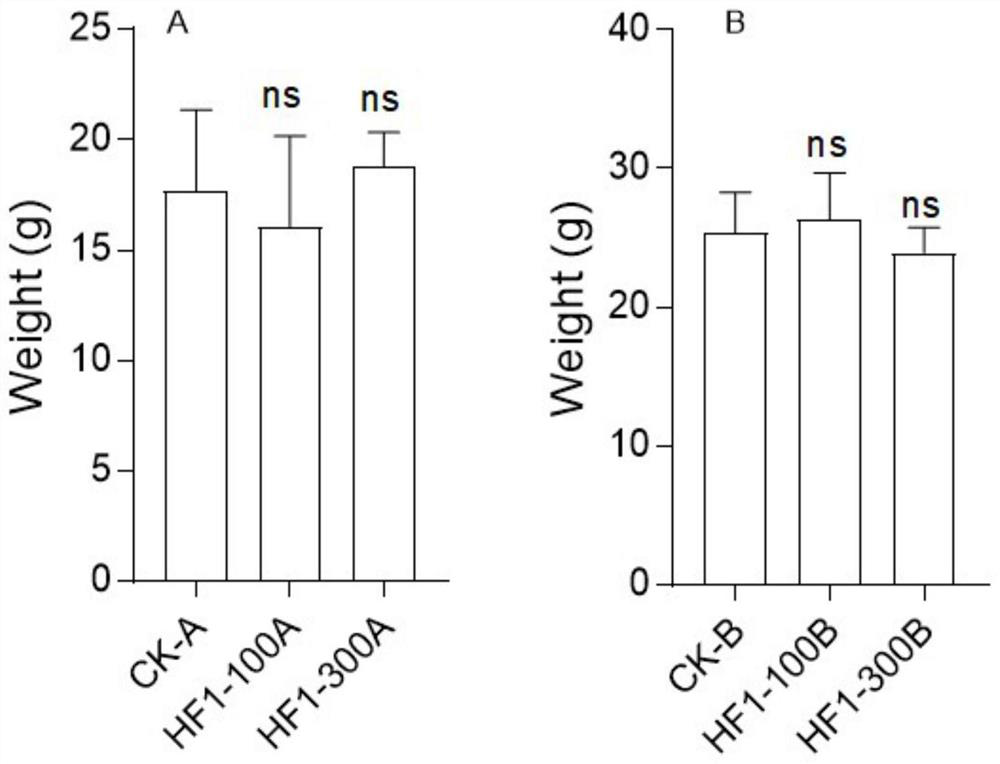Application of bacillus subtilis HF1 to astragalus membranaceus planting
A technology of Bacillus subtilis and HF-1, applied in the field of microorganisms, can solve the problems of excessive pesticide residues in Astragalus membranaceus, limit the sustainable production and output of Astragalus membranaceus, affect the food safety of Astragalus membranaceus, and achieve the effect of changing community changes
- Summary
- Abstract
- Description
- Claims
- Application Information
AI Technical Summary
Problems solved by technology
Method used
Image
Examples
Embodiment 1
[0031] The present embodiment provides a kind of preparation method of Bacillus subtilis (Bacillus subtilis) HF1 fermented liquid, specifically comprises the steps:
[0032] (1) After activating the Bacillus subtilis HF1 strain on the plate, pick the monoclonal strain, inoculate it into 100 mL of LB medium, and culture it overnight on a shaker at 30° C. and 200 rpm.
[0033] (2) Inoculate the Bacillus subtilis HF1 strain into 2L of LB medium, culture on a shaker at 30° C. and 150 rpm for 36 hours, collect the fermentation broth and store it at room temperature for later use.
Embodiment 2
[0035] The present embodiment provides a kind of application method of Bacillus subtilis (Bacillus subtilis) HF1, specifically as follows:
[0036] 1. Community settings
[0037] Land plots: divided into non-heavy-cropping land and heavy-cropping land, located in;
[0038] Seedling selection: select astragalus seedlings of similar size;
[0039] Planting method: ditching, about 15cm deep, about 2m long, 40cm row spacing, place seedlings in the same direction, place 10 seedlings in each ditch, 5 ditches for each plot, repeat each plot as a treatment, each treatment Repeat 3 times.
[0040] 2. Seedling treatment
[0041] Get the Bacillus subtilis (Bacillus subtilis) HF1 fermented liquid that embodiment 1 provides to carry out experiment in non-replanted land (marked as A) and replanted land (marked as B); Before covering soil, fermented liquid is diluted 100 times and 300 times respectively with clear water times, use a sprayer to evenly spray the diluted solution on the soi...
Embodiment 3
[0043] In this example, the control effect of Bacillus subtilis HF1 grown in Example 2 and the content of effective components of Astragalus membranaceus were tested.
[0044] 1. Disease classification and disease index processing standards:
[0045] According to the degree of damage of Astragalus root disease, this experiment divides the disease into 5 levels, as follows:
[0046] Grade 0, no lesion;
[0047] Grade 1, no large blackhead lesions at the junction of rhizomes, and less than 10 lesions in other places;
[0048]Grade 3, no large blackhead lesions at the junction of rhizomes, and more than 10 lesions in other places;
[0049] Grade 5, there are large blackhead lesions at the junction of rhizomes, and the number of lesions in other places is less than 10;
[0050] Grade 7, there are large blackhead lesions at the junction of rhizomes, and the number of lesions in other places is more than 10.
[0051] Disease index = ∑ (number of diseased plants at all levels × v...
PUM
 Login to View More
Login to View More Abstract
Description
Claims
Application Information
 Login to View More
Login to View More - R&D
- Intellectual Property
- Life Sciences
- Materials
- Tech Scout
- Unparalleled Data Quality
- Higher Quality Content
- 60% Fewer Hallucinations
Browse by: Latest US Patents, China's latest patents, Technical Efficacy Thesaurus, Application Domain, Technology Topic, Popular Technical Reports.
© 2025 PatSnap. All rights reserved.Legal|Privacy policy|Modern Slavery Act Transparency Statement|Sitemap|About US| Contact US: help@patsnap.com



